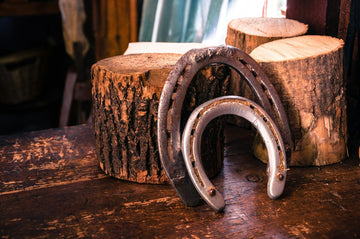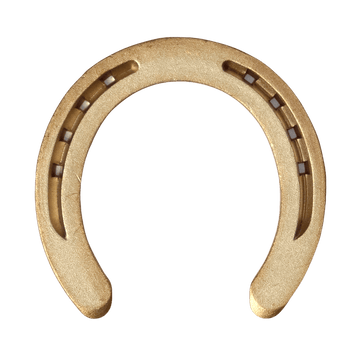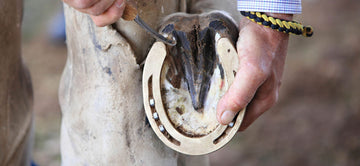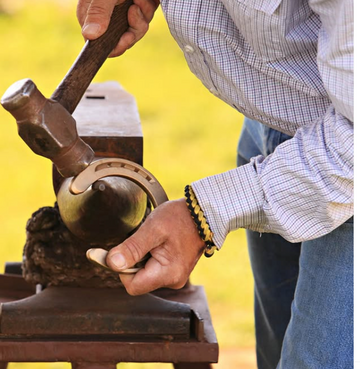Horseshoes are an integral part of equine care, serving both functional and protective roles for horses.
Whether you're a seasoned horse owner or a new enthusiast, understanding why horses need shoes is important for making informed decisions about hoof care.
In this guide, we will explore the purpose of horseshoes, the history behind them, their benefits, potential drawbacks, and the alternatives available for hoof protection.
What are Horseshoes and Their Purpose?
Horseshoes are U-shaped metal plates designed to protect the hooves of horses. These shoes are typically made from materials such as steel or aluminum and are attached to the horse's hooves with nails or glue.
The primary purpose of horseshoes is to provide support, protection, and traction, especially for horses that are used for work, riding, or other strenuous activities.
A horse that wears shoes is referred to as a "shod horse," whereas a horse without shoes is termed "unshod" or "barefoot." The decision to shoe a horse depends on various factors, including the horse's environment, workload, and hoof health.
The History of Horseshoeing
The practice of horseshoeing dates back thousands of years, beginning with ancient civilizations that used various materials to protect horses' hooves. Initially, horseshoes were made from leather or other primitive materials, but over time, iron and bronze became more commonly used.
By AD 910, iron horseshoes were introduced in Europe, marking the first known appearance of the metal shoe.
Horseshoes evolved as horse owners and farriers (hoof care professionals) developed new techniques to improve their effectiveness. Today, horseshoes come in various forms, materials, and designs to meet the specific needs of different horses.

Why Do Horses Wear Shoes?
Protection and Support
Horseshoes are primarily worn to protect and strengthen a horse’s hooves. Hoof protection is especially important for horses used in various activities, such as racing, trail riding, or farm work.
Horses that work on hard or rocky ground are more likely to wear down their hooves quickly, making shoes a necessary solution to prevent damage.
Working horses, which carry heavy loads or perform strenuous tasks, experience more rapid hoof wear than wild horses, making shoes essential for maintaining hoof health and preventing injury.
Traction and Stability
Horseshoes provide additional traction, which is essential for a horse's hooves performing various tasks, especially on slippery or uneven surfaces. Shoeing also helps distribute the weight of the horse evenly across its hooves, preventing excessive pressure on specific areas and reducing the risk of lameness or other hoof-related issues.
Medical Benefits
In addition to providing protection, horseshoes can also be used to treat certain medical conditions such as laminitis, navicular disease, or hoof wall defects. For example, horseshoes can stabilize the hooves in horses with laminitis, providing relief from pain and preventing further damage.
Do Horses Need Shoes?
The decision to shoe a horse is a complex one, influenced by various factors such as the horse’s breed, age, riding discipline, and individual needs.
While some horses may require shoes to protect their hooves from wear and tear, others may not need them at all. In fact, many horse owners and experts believe that horses can thrive without shoes, provided they receive proper care and maintenance.
Horses that are ridden lightly or live in areas with soft terrain may not need shoes, as their hooves can naturally absorb impact and distribute weight.
On the other hand, horses that are frequently ridden or engage in high-impact activities may benefit from wearing shoes to provide additional support and protection to their hooves.
It’s also important to note that domesticated horses have different hoof needs compared to wild horses. Wild horses roam freely and wear down their hooves naturally on varied terrain, whereas domesticated horses often require more frequent trimming and maintenance to prevent hoof problems.
This difference in lifestyle and environment means that horse owners must carefully consider whether their horses need shoes based on their specific circumstances.

Horses That Wear Shoes
Horses that wear shoes are typically referred to as shod horses. These horses require regular shoeing to maintain the health and integrity of their hooves. The type of shoe used can vary depending on the horse’s breed, age, and riding discipline.
For instance, horses used for heavy work or high-impact activities may need specialized shoes, such as eggbar shoes or heartbar shoes, to provide extra support and protection. Conversely, horses that are ridden lightly or live in areas with soft terrain might benefit from lighter shoes or even hoof boots.
Hoof boots are a flexible and removable alternative to traditional nailed-on shoes. They are often used for horses that are sensitive to nails or have specific hoof-related conditions.
Made from materials like rubber, plastic, and leather, hoof boots can be customized to fit the individual horse’s needs, offering protection and support without the permanence of nailed shoes.
In addition to providing protection and support, shoes can help redistribute the horse’s weight and pressure, which can prevent conditions like laminitis and other hoof-related issues. However, it’s crucial to ensure that shoes are fitted properly, as poorly fitted shoes can cause discomfort and hoof pain.
Ultimately, the decision to shoe a horse should be based on individual circumstances, considering the horse’s breed, age, riding discipline, and specific needs. With proper care and maintenance, horses can thrive with or without shoes, enjoying healthy feet and a happy, active life.
The Pros and Cons of Shoeing a Horse
Pros of Horseshoes
-
Hoof Support: Shoes provide support to the horse’s hoof and internal structures, preventing excessive wear and tear, particularly in horses working on hard ground.
-
Protection: Horseshoes offer protection against injury, especially for horses that work on rough terrains like gravel, rocky trails, or paved roads.
-
Medical Treatment: Horseshoes can be used as part of treatment for medical conditions such as laminitis or navicular disease, helping to reduce pain and improve hoof health.
-
Performance Enhancement: Shoeing can enhance a horse’s performance, providing better traction and stability during physical activity, such as racing or jumping.
-
Horse Shoes: Horse shoes protect the hooves and improve traction, but improper application can lead to discomfort and harm, similar to the importance of proper footwear for humans.
Cons of Horseshoes
-
Natural Hoof Weakening: Prolonged use of shoes may weaken the natural hoof structure if not done correctly. The hoof may become dependent on the shoe for support.
-
Cost: The cost of horseshoeing can add up over time, especially if the horse needs frequent re-shoeing or special shoeing for medical reasons.
-
Risk of Shoe Loss: Horses can lose shoes while working or in the pasture, which may cause discomfort or damage to the hoof.
-
Impaired Natural Foot Balance: Improperly fitted shoes or incorrect shoeing techniques can lead to improper foot alignment, causing lameness or other hoof-related problems.
Horse owners should carefully weigh the pros and cons of shoeing and make decisions based on their horse's specific needs, environment, and work requirements.
Horse Hoof Maintenance and Alternatives to Shoes
Proper hoof maintenance is essential for maintaining the health of the horse's hooves, whether or not shoes are used.
Horses with shoes require regular trimming and shoe replacement every 6-8 weeks during the summer and every 6-12 weeks in the winter.
Alternatives to Traditional Shoes
There are several alternatives to traditional nailed horseshoes:
-
Glue-On Shoes: These shoes are glued to the hoof wall and provide an option for horses with hoof wall defects or sensitivity to nails.
-
Hoof Boots: Hoof boots are a flexible and removable alternative, often used for horses that require occasional hoof protection during work or riding.
-
Wooden Shoes: These are sometimes used for therapeutic purposes, helping to stabilize the hoof and promote better growth.
-
Barefoot Trimming: Some horses can live and work without shoes by having their hooves regularly trimmed and maintained to promote natural growth and strength.
The Role of the Farrier in Horse Care
A farrier is a professional specializing in equine hoof care, including trimming, shoeing, and addressing hoof health issues. Farriers play a vital role in ensuring the health of horses' hooves and overall well-being. They are skilled in assessing hoof conditions, identifying potential problems, and applying the appropriate footwear or treatment.
Regular visits from a farrier are essential for maintaining healthy hooves, especially for horses involved in physical activities or those requiring medical treatment for hoof-related conditions.
The Re-Shoeing Process and Frequency
The re-shoeing process involves removing the old horseshoes, trimming the hooves to remove excess growth, and then attaching new shoes. A farrier may choose between hot or cold shoeing methods based on the horse's needs.
Hot shoeing involves heating the shoe and shaping it to fit the horse’s hoof, while cold shoeing uses pre-made shoes that are shaped without heat.
Horses typically require re-shoeing every 6-8 weeks, depending on their activity level, hoof health, and type of shoes used. Regular monitoring and re-shoeing are crucial for maintaining the health and comfort of a horse’s hooves.
The Impact of Shoes on Horse Hooves
Wearing horseshoes helps distribute the weight of the horse evenly across the hooves, reducing the strain on specific areas.
Proper shoeing can help prevent conditions like laminitis, which is caused by stress and inflammation in the hoof tissues. However, improper shoeing or using poorly fitted shoes can lead to problems such as lameness, hoof imbalance, or damage to the hoof wall.
Trail Riding and Hoof Protection
Trail riding horses, often called hack horses, can benefit significantly from horseshoes, as they help provide traction on challenging surfaces such as rocky trails, slippery roads, or hard-packed soil.
Horseshoes protect the hooves from excessive wear and tear while also improving the horse's grip and stability during outdoor activities.
For horses that are only occasionally ridden or require temporary hoof protection, hoof boots can be a suitable alternative. These boots are easy to put on and take off and can be used to provide extra support when needed.
Monitoring Horse Hooves for Hoof Health
Regular inspection of a horse's hooves is essential for maintaining their overall health and comfort. Look for signs of wear, cracks, or other issues, and consult a farrier or veterinarian if any problems arise.
Horses should also be monitored for signs of lameness or discomfort, as untreated hoof issues can lead to more severe conditions.
Frequently Asked Questions
What Happens If a Horse Doesn’t Have Shoes?
Horses can survive without shoes if their hooves are healthy and properly maintained. However, horses involved in heavy work or those exposed to hard, rocky surfaces may experience wear and damage to their hooves, which can cause discomfort or lameness.
Can Horses Survive Without Shoes?
Yes, many horses, especially those with strong, healthy hooves, can live and work without shoes. Regular trimming and proper hoof care can ensure that barefoot horses stay healthy.
Why Do Horses Need Shoes But Not in the Wild?
Wild horses are accustomed to living in natural environments with soft, uneven terrain that wears down their hooves naturally. Domesticated horses, however, often live and work on hard surfaces that don’t provide the same wear, making shoes necessary to protect and maintain their hooves.
Is It Painful for Horses to Get Shoes?
When done correctly, shoeing does not cause pain. Farriers use specialized tools to carefully trim and fit shoes without causing discomfort. However, improper shoeing can lead to pain or injury, so it’s important to work with a skilled farrier.
Why Does a Horse Need Shoes Conclusion
Horseshoes are an essential part of hoof care for many domesticated horses, offering protection, support, and improved performance.
While there are both benefits and drawbacks to shoeing, it’s essential to assess each horse’s individual needs to make an informed decision.
Regular hoof care and consultation with a farrier are key to maintaining healthy hooves and preventing hoof-related issues.
Whether opting for traditional shoes, hoof boots, or barefoot trimming, the goal is always to ensure the comfort and well-being of the horse.










